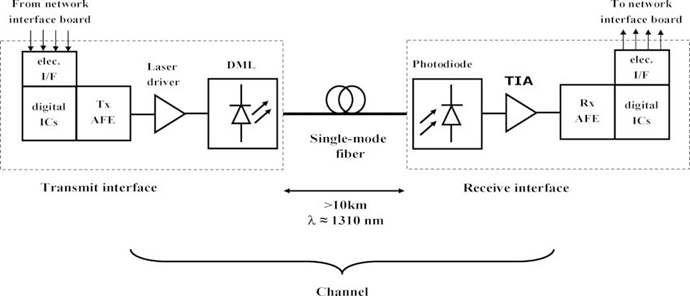-
Optical transmission refers to transmitting information, such as data, voice, or video signals, over optical fibers using light as the medium. It involves converting electrical signals into optical signals and transmitting them through fiber-optic cables to achieve high-speed and long-distance communication.
-
In an optical transmission system, the information is encoded into light signals, which are then launched into the core of the optical fiber. The core of the fiber is typically made of a highly transparent material, such as glass or plastic, which allows the light to travel through it with minimal loss or attenuation.
-
The transmission of information through optical fibers relies on the principle of total internal reflection. When a light signal enters the core of the fiber at a specific angle, it undergoes multiple internal reflections, bouncing back and forth within the fiber core. This phenomenon keeps the light confined within the core and enables it to propagate along the fiber over long distances.
What are the different techniques and technologies used in optical transmission systems?
-
Modulation: The information to be transmitted is encoded onto the light signal by modulating its intensity, phase, or frequency. This modulation can be achieved using various modulation techniques, such as amplitude modulation (AM), frequency modulation (FM), or phase modulation (PM).
-
Laser Diodes: Laser diodes are commonly used as light sources in optical transmission systems. They emit coherent and monochromatic light at specific wavelengths, providing a highly focused and efficient light signal for transmission.
-
Wavelength Division Multiplexing (WDM): WDM is a technique that allows multiple signals to be transmitted simultaneously over a single optical fiber by assigning different wavelengths (colors) of light to each signal. This enables high-capacity transmission and efficient utilization of the available fiber bandwidth.
-
Optical Amplification: As the light signal travels through the fiber, it experiences some loss due to attenuation. Optical amplifiers, such as erbium-doped fiber amplifiers (EDFAs), are used to boost the power of the light signal at regular intervals along the fiber, compensating for the loss and extending the transmission distance.
-
Optical Modulators and Receivers: At the receiving end, optical modulators and receivers are used to convert the received optical signals back into electrical signals for processing and decoding. These devices detect the modulated light signals and extract the encoded information from them.
Optical transmission offers several advantages over traditional electrical transmission, including higher data rates, longer transmission distances, lower signal degradation, and immunity to electromagnetic interference.
Credits: ![]()
